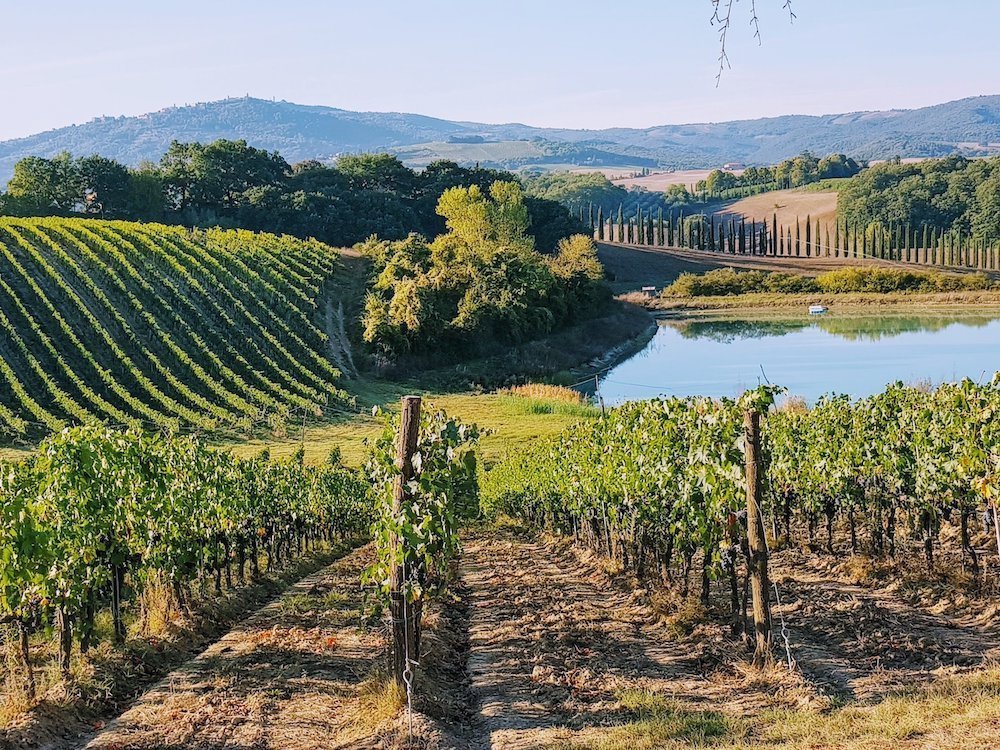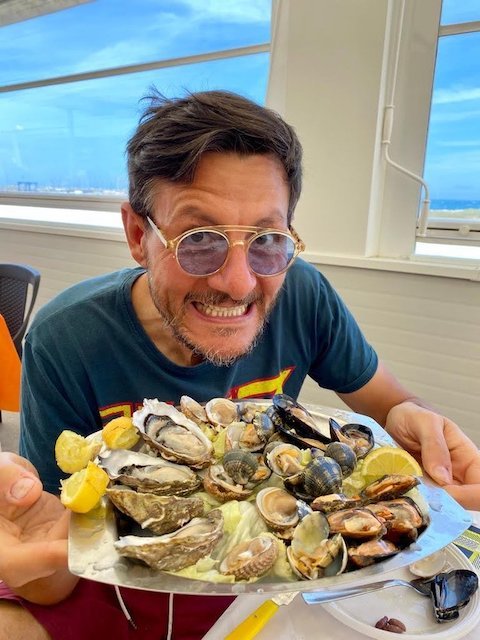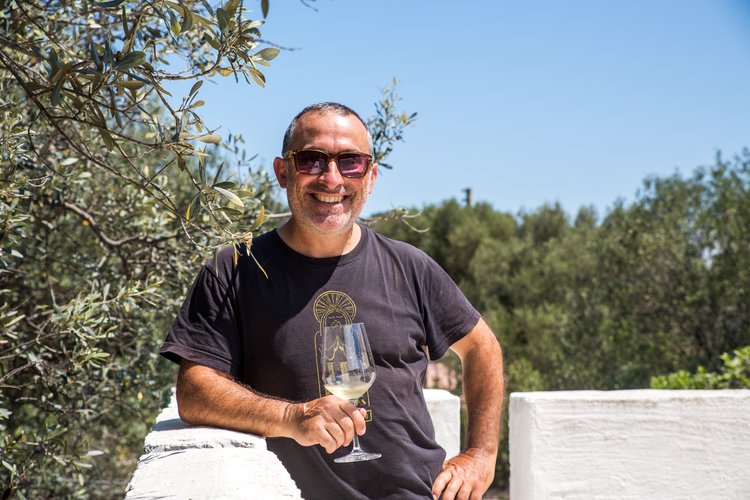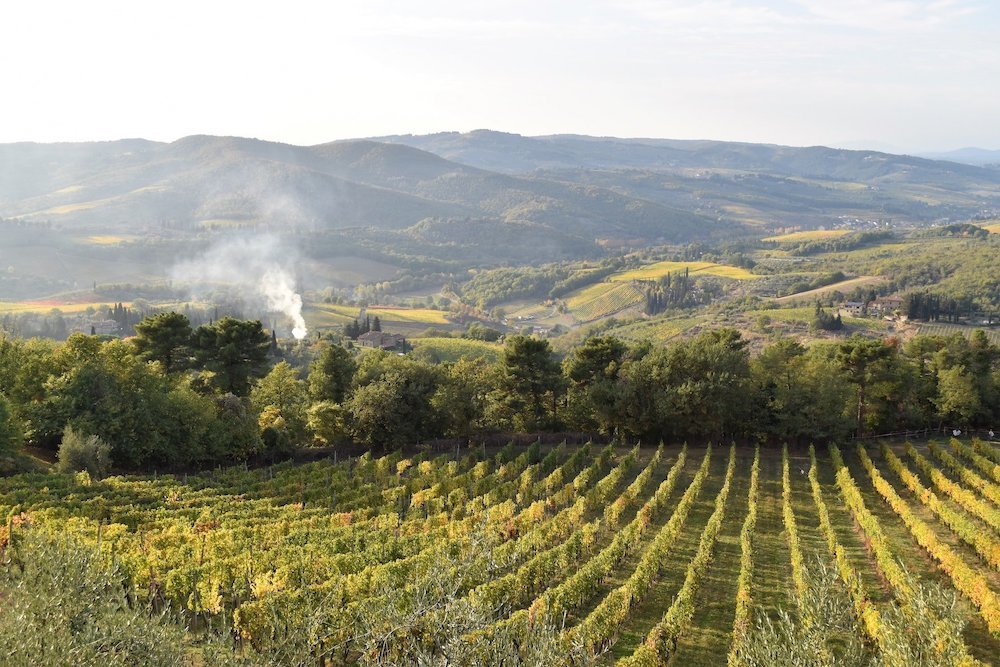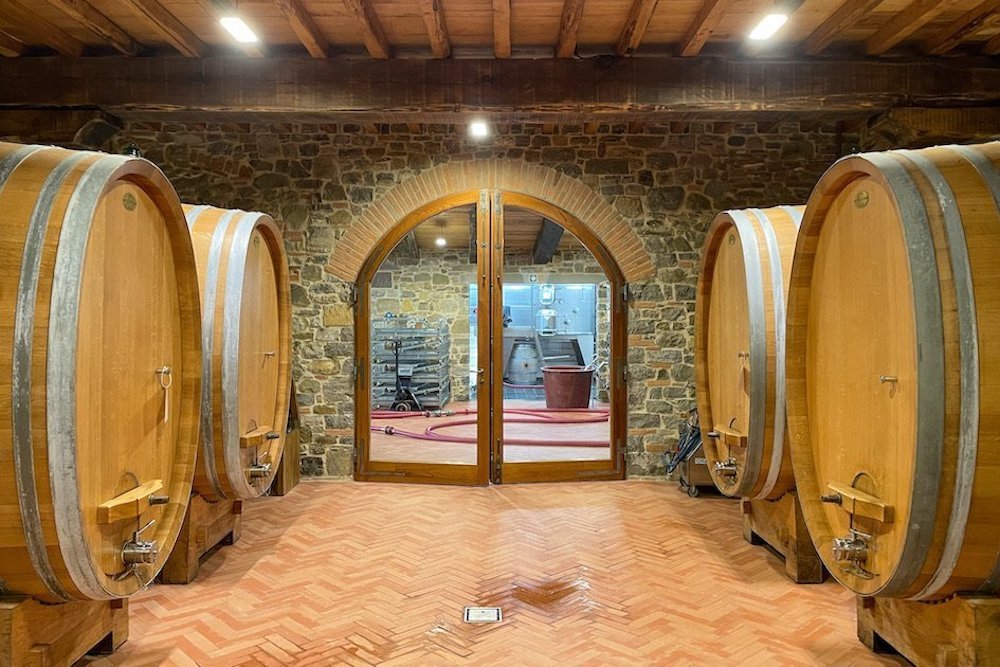The Definitive Guide to Wine & Wine Touring in Tuscany
Affiliate disclosure: some of the links in this article are affiliate links. If you book using one of them, we’ll earn a small commission. All of our info is free to read and free of ads, so we appreciate it!
For most visitors to Tuscany, a highlight of their trip is spending a day or two exploring the region’s beautiful wineries and sampling Tuscany’s distinct wines.
So, to help you prepare for some wine drinking and wine touring during your visit, we sat down with Florence native, sommelier, and wine-focused tour guide Stefano to get the lowdown on all things wine in Tuscany.
First things things first, Tuscany is a large region with many different wine-producing sub-regions, each with different styles of wine and distinct atmospheres. Among the principle areas of interest are:
Chianti (Chianti Classico)
Montalcino (Brunello)
Montepulciano (Vino Nobile)
San Gimignano (Vernaccia)
Most of these towns are in the provinces of either Siena or Florence; the epicenter of Tuscan wine production. But there are many other areas worth visiting, like Bolgheri, Carmignano, and Maremma for example. No matter where you go, you’ll have an ample selection of wineries to choose from.
If you’re interested in immersive experiences, staying in a traditional agriturismo, especially one with its own vineyards where you can enjoy tastings without needing to think about driving, will undoubtedly be an unforgettable experience.
And if you’re here at the right time of year (early fall), you may even be treated to one of the region’s many wine festivals, events, or sagre (hyperlocal municipal festivities) which can be an excellent way of experiencing the wine culture and sampling a wide variety of wines while surrounded by locals.
Table of Contents
Tuscany planning cheatsheet
 Plan your itinerary with expert advice
Plan your itinerary with expert advice
- Book an Italy travel consultation with a local expert
 My favorite hotels in Tuscany
My favorite hotels in Tuscany
- Hotel Calimala - Gorgeous boutique hotel in Florence's historic center. $250-450 USD
- Locanda de Ciomp - Excellent value guesthouse in Florence. $150-200 USD
- Palazzo Ravizza - Lovely midrange option in Siena. $120-175 USD
- Castello di Fonterutoli - Delightful castle & winery resort in the Chianti countryside. $200-300 USD
- Meublé il Riccio - Historic property in the heart of Montepulciano. $160 USD
- La Casa Di Adelina - Charming B&B in the Val d'Orcia village of Montichiello. $130 USD
 Guided tours and activities
Guided tours and activities
 How to get around
How to get around
- Car rentals with DiscoverCars
- Train tickets from Trenitalia and Italo
- Bus routes via Autolinee Toscane, Sitabus, and Flixbus
Where to base yourself for wine touring in Tuscany
Tuscany is the land of wine trips and you have wine-growing regions almost everywhere you go!
Where to base yourself in Tuscany for wine touring is an important question and there is no easy answer. If you won’t have a car and will be relying on public transport or tours, choosing a city like Florence or Siena is a wise decision.
If you’ll be driving, your options expand significantly. But don’t make the common mistake of thinking that everything is close by. Tuscany is a large region and you could spend hours driving from one end to another.
A very popular choice for many travelers is to spend a few days in Florence, Siena, or the Chianti area, and then a few more days in the Val d’Orcia. If you have more time, you might consider a stay in Maremma or even heading out to the coast around Monte Argentario.
Most wine tours in Tuscany focus on two main regions: the Chianti Classico and the Val d’Orcia. Bear in mind that these regions, while fairly close on the map, are actually pretty far apart. For example, getting from Florence to Montepulciano (a town in the Val d’Orcia) can take about 2 hours and there is really no public transport.
Florence to the Chianti Classico towns takes anywhere from 30 minutes to an hour, and again, you don’t have any public transport unless you first pass through Siena.
If you’re only going to have one base in Tuscany and want to see a bit of everything, the best location is probably Siena. The closest Chianti Classico town of Castelnuovo Berardenga is only 20 minutes away and you’re an hour from Montepulciano and other parts of the Val d’Orcia.
You’ll also have public transport options to Florence and at least some buses to the Chianti Classico towns.
Our recommendation is to split up your time and go with two different bases. After all, at the end of a long day of sightseeing, the last thing that you want is a 2-hour drive home. This will also let you see more and get a better feeling for Tuscany on a whole.
Here are some of our favorite locations to base yourself for day trips, sightseeing, and wine touring:
Florence
Basing yourself in Florence is always a good choice as you have the amenities of a big city, but are right nearby to very popular wine destinations like the Chianti Classico. You’re also close enough to easily reach towns like Montalcino and Montepulciano in the Val d’Orcia.
Florence’s proximity to each of these wine-producing powerhouses, and the availability of organized tours and local guides, makes it an obvious choice for anyone interested in doing multiple day trips to different wineries/areas, especially if you won’t have a car.
Carmignano
If you prefer to stay in smaller towns, Carmignano is a little gem just outside the city of Florence. Here, they produce powerful, rich, full-bodied wines made from international varieties like Cabernet Sauvignon and Merlot.
San Gimignano
Surrounding San Gimignano, Vernaccia di San Gimignano is a decent wine depending on the producers. However, it is the fame of the city, and not the wine, that has made this area famous. Because of the constant flow of tourists to San Gimignano, there’s been a spillover effect that has resulted in the area’s local wine also becoming popular.
The Vernaccia here is generally a light mineral white wine with a few great producers and many more anonymous, not-so-interesting ones. San Gimignano is conveniently located to other nice areas for sightseeing, so can make a nice base for both wine touring and sightseeing, provided you don’t mind the constant crowds.
Siena
For a base that’s somewhere smaller than Florence, but has more going on than the myriad sleepy hill-top towns, Siena is a perennially good option. Siena is a real city with a fantastic historic core, loads of sightseeing, and a great restaurant scene.
Additionally, its location just on the edge of the Chianti Classico area means you have super easy access to many famous wineries, as well as lots of smaller, locally-owned ones. Castello di Volpaia and Castello di Fonterutoli are two notable wineries, but you’ll have an almost endless number of choices to visit from here.
Montalcino
One might also find it fitting to set up shop for a few days in Montalcino, smack in the heart of the gorgeous Val d’Orcia. This is the home of the famous Brunello di Montalcino wine and the town makes a great base for those with a car who are planning on day trips.
It is a charming, medieval hill-top town that has its own fantastic wine culture, and it’s just a short drive from some major wineries, such as Biondi Santi and Il Poggione, among many others.
A little more off the beaten path
Other areas that you might want to consider are the Alpi Apuane, Bolgheri, Castagneto Carducci, Montepulciano, and Pienza.
Wine/winery Tours in Tuscany
Most wineries offer tours and tastings which usually include a tour of the vineyards and facilities, a demonstration and/or description of their production process, and of course, a tasting. In many cases, you can just show up and request a tour or join one of many pre-scheduled ones.
Some wineries though, especially smaller, locally owned ones, do require appointments. It’s always best to call ahead and check. Also know, wine tastings at wineries in Tuscany usually aren’t free.
As you plan for some winery tours, remember that your two main areas of interest, and where the vast majority of organized wine tours go, are the Chianti Classico and Val d’Orcia.
Chianti Classico
The Chianti Classico consists of 9 towns situated between Florence and Siena: Radda in Chianti, Castellina in Chianti, Greve in Chianti, Gaiole in Chianti, Panzano in Chianti, Barberino Tavarnelle, Castelnuovo Berardenga, Poggibonsi, and San Casciano in Val di Pesa.
If your goal is to tour the Chianti area, you should plan to stay in Florence, Siena, or one of the 9 Chianti Classico towns. Staying somewhere adjacent to them is also of course fine (and cheaper).
For more info on wine and wineries in Chianti, check out our guide to wine touring in Chianti.
Val d’Orcia
The Val d’Orcia is a larger region in Southern Tuscany that includes the towns of Montalcino, Castiglione d'Orcia, Pienza, Radicofani, Bagno Vignoni, and San Quirico d'Orcia. Montepulciano is not technically part of it, but it’s right next door so gets included.
If you’re planning on touring the Val d’Orcia for more than a day or two, you should consider staying somewhere like Montalcino, Montepulciano, or Pienza. Like with Chianti, choosing other nearby towns that aren’t such big names will get you better prices and fewer crowds.
This area is full of agriturismi which are a sort of cross between a farm and a b&b. You have all different levels of class, ranging from very rustic working farms to luxury properties. Often, you can arrange for half-board with communal dinners of fresh local products included. You also have many villas and private residences available for rent.
For more info on wine in the Val d’Orcia check out out comprehensive guide to wine and wineries of the Val d’Orcia
Group tours
Most group wine tours will be for 8-20 people and will visit 2 or 3 wineries and include a stop for exploring in a town or two. If you’re a solo traveller or just a few people, these are your most cost-effective option aside from driving (if you’ll be tasting wines, please don’t drive).
Due to the large group sizes, these tours typically visit larger, more commercial wineries and they can feel a little canned and cookie-cutter. Tours typically leave from Florence, Siena, and a couple of other larger towns favorited by tourists. Expect them to last a full day; about 7-9 hours.
Private tours
Private tours are the best way to get off the beaten path and experience less-visited Tuscany, and sample unique Tuscan wines, at your own pace. Many local guides run private tours for groups of 1-8 travelers and can fully customize them to you to include wineries of your choice and interesting sightseeing stops. This is a great way to combine both drinking and touring.
If you’re considering a private wine tour of Chianti, check out our favorite wine-crazed local guide, Stefano.
Stefano is a certified sommelier and licensed guide who focuses on small, boutique wineries with sustainable production and extremely high quality wines, many of which you cannot find outside of Italy.
For private wine tours in the Val d’Orcia, we always recommend Serena, a local guide and sommelier based out of Montepulciano.


Tuscan wines to try
Tuscany has its fair share of wines, so below is an overview of some of the most popular ones as well as a few of our favorites.
Chianti Classico
A truly excellent wine, the Chianti Classico should be on the top of your list of wines to try when visiting this region. Producers have reached incredible levels of quality, and many of the wineries and vineyards in the area are quite charming.
Vino Nobile di Montepulciano
Vino Nobile di Montepulciano is another red, made from a blend of sangiovese, cannaiolo, and other wines. It must be at least 70% sangiovese. It’s an excellent wine for aging and is not as full-bodied as a Brunello, so makes for a bit easier drinking.
Brunello di Montalcino
Brunello, a red produced in the hills around Montalcino in the Val d’Orcia, is an intensely aromatic, light, and intense 100% sangiovese wine. It’s elegant and smooth with a full body that is not overpowering. It’s a high-alcohol wine, so expect 14 and 15%.
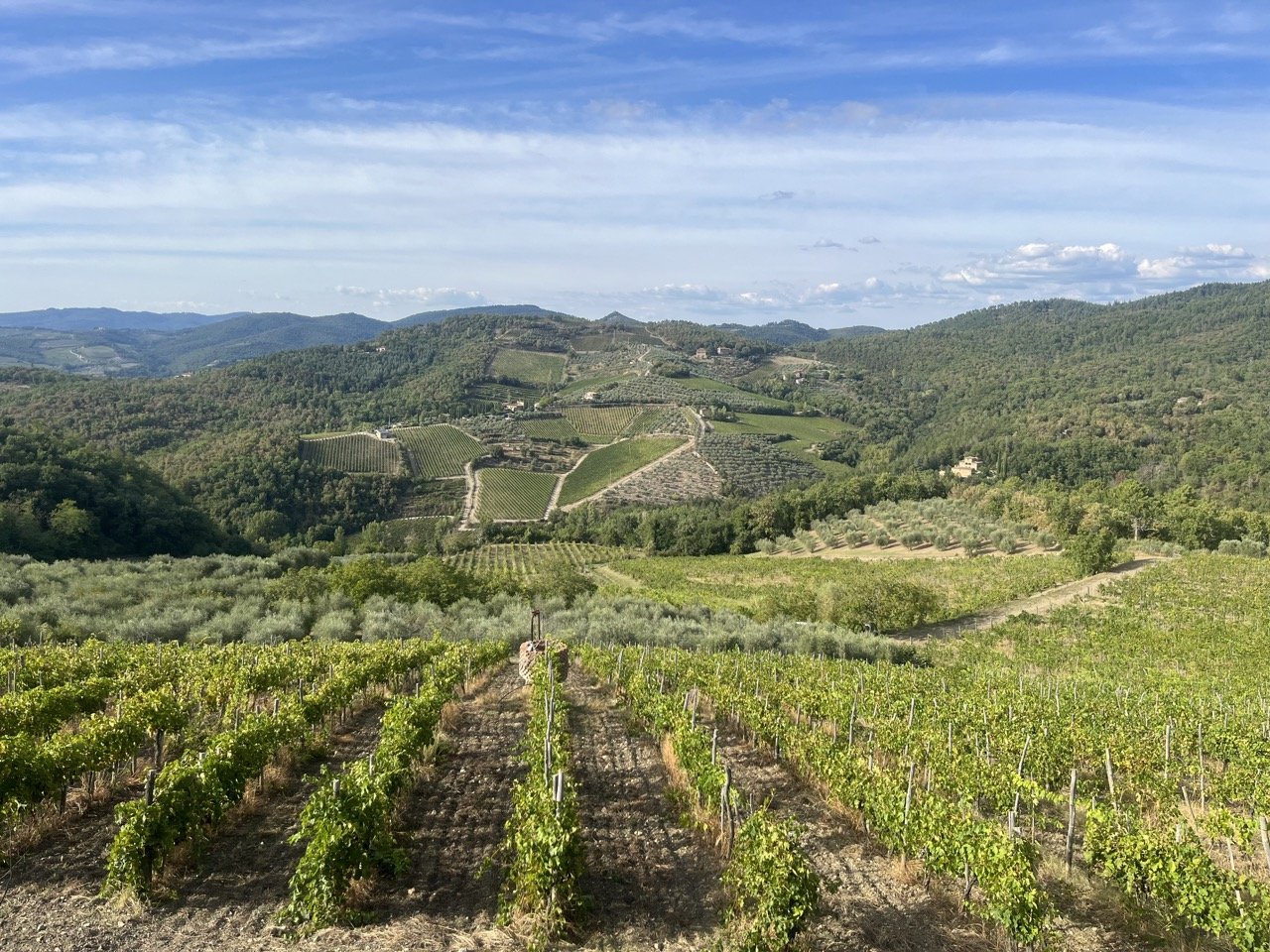
Bolgheri
Bolgheri, while not as famous as some of the other names on this list, is a lovely red with a very international taste profile. While you can find wines made from a single varietal, most are a blend of primarily Cabernet Sauvignon and some combination of Merlot, Cabernet Franc, and/or Petit Verdot.
Unlike the other wines mentioned which are grown in the interior, Bolgheri is produced on the coast of Tuscany in the Maremma region. The proximity to the coast lends the wine a very distinct flair from the others.
Montecucco
Less known than the heavy hitters mentioned before, Montecucco is similar to Montalcino; a powerful, rich, succulent wine. Being far less famous, you’ll find it at a much better price point.
Suvereto
Suvereto is both a wine and a town. The wine itself is good, and the town is a lovely place for sampling local varietals. A good plan when visiting is to combine a tasting with a visit to the beautiful village, along with a stop in nearby Castagneto Carducci.
There are of course many other wines that are worth trying, but the above selection gives you a nice variety, with differing flavors and profiles.
15 terrific wineries in Tuscany
This list includes 18 wineries spread out across the Chianti and Val d’Orcia region. It is by no means a list of the “best” wineries in Tuscany, nor does it include any of the countless terrific producers based in other areas of the region, like the Maremma coast or the hills around Cortona. Nonetheless, it’s a good starting point in your research.
The first 8 wineries are in the Val d’Orcia region while the final 7 are in Chianti.
1. Argiano
Argiano has developed organic methods for producing its Brunello, Rosso di Montalcino, and IGTs that include Solengo, a so-called Super Tuscan, a coined term for creative reds created under the IGT designation.
Extensive tours include strolls through the vineyards and visits to the production facilities and vineyards, followed by tastings.
2. Avignonesi
Avignonesi, in the hamlet of Valiano di Montepulciano, produces a large range of reds, whites, and roses designated as IGTs, as well as vin santo and grappa. This is a good place to taste wines that fall outside of the classic DOC and DOGC classifications, and you can sample them at tastings or at a gourmet lunch in which the estate wines are paired with menus.
They also offer cooking classes that end with a four-course meal paired with the best wines.
3. Biondi Santi
Franco Biondi Santi-Tenuta Greppo might be the most storied vineyard in the region, since here in 1888 Clemente Santi created the wine we now recognize as Brunello. Tastings are by appointment only.
4. Corte Pavone
Corte Pavone Winery, at the end of a cypress-lined drive west of Montalcino, hosts tastings of its Brunello as well as Rosso del Montalcino, along with a refreshing Spumante.
5. Il Poggione
Il Poggione is another legendary Montalcino institution and has been bringing Brunello to the market for more than a century. Aside from Brunello and Rosso di Montalcino, the estate produces a younger Rosso di Toscano and Bianco di Toscano. Tastings are by appointment only.
Brunello enthusiasts might consider a stay at the rustically luxurious Agriturismo il Poggione, where private tastings and tours are among the added amenities.
6. Le Buche
Le Buche, at the eastern edge of the Val d’Orcia north of Bagni San Filippo, shows off its Orcia DOC reds and whites and other wines with hospitality that includes picnics with wine pairings and e-bike tours of the vineyards with a stop in the tasting rooms.
7. Montemercurio
Montemercurio, between Montepulciano and Pienza, is a small producer of Vino Nobile di Montepulicano. A visit to the vineyards and winery and tastings, by reservation only, provide a close-up look at the wines of this noted DOCG designation.
8. Poggio Antico
Poggio Antico, an august producer of Brunello, hosts tastings in its extensive shop, as well as guided tours of its beautiful vineyards on high ground (poggio means “knoll”) outside Montalcino.
9. Badia a Coltibuono
Bada a Colitbuono, set in a nature preserve high above Gaiole, is an ancient monastery turned bastion of luxury, with beautiful surroundings that include formal gardens. Wines include Chianti Classico, Vin Santo, and some noteworthy IGTs, and the estate also produces olive oil. Tours are followed by tastings that can be accompanied by appetizers or lunch. Cooking classes are also available, as are stylish accommodations.
10. Barone Ricasoli
Barone Ricasoli is the oldest winery in the world, established in 1141 at Castello di Brolio outside Gaiole. Here in the mid-19th century Barone Bettino Ricasoli came up with the blend still used for the region’s acclaimed Chianti Classico wine. Visits can include tastings and a tour of cellars and the castle, including a walk along the ramparts, with views across miles of vineyards and forests of oak. Dinners, accompanied by estate wines, are also available.
11. Castellare
Castellare, outside Castellina in Chianti, sits at 1,200 feet, higher than almost any other Chianti Classico vineyard. The estate also produces many notable IGTs, with labels emblazoned with the many species of birds that thrive on the estate. Guided tours of the cantina and tastings are by appointment.
12. Castello di Ama
Castello di Ama is a hamlet consisting of a castle and a cluster of adjoining worker’s houses outside Gaiole. The surrounding vineyards yield renowned Chianti Classicos and Tuscan IGTs that you can enjoy at tastings in the enoteca or over meals at the excellent restaurant. A visit includes a stroll through the gardens and grounds full of art installations.
13. Castello di Verrazzano
Americans might feel a special affinity at the Castello di Verrazzano, outside Greve. The explorer Giovanni da Verrazzano, who discovered New York Bay, was born here in 1485 and his image appears on the labels of the estate’s wines that include acclaimed Chianti Classicos as well as IGT reds, whites, and roses. Visits include guided tours of the gardens and centuries-old cellars, combined with tastings or lunch or dinner.
14. Castello Vicchiomaggio
Walls and towers of the 11th-century Castello Vicchiomaggio remain, along with a splendid Renaissance manor at which Leonardo da Vinci was once a house guest. Aside from Chianti Classico, the estate, outside Greve, produces several Tuscan IGTs from grapes that include Canaiolo and Colorino. Tours, tastings, and lunch and dinner are on offer, along with distinctive accommodations.
15. Fattoria Lamole
Fattoria Lamole is a farm surrounded by oak forests on a mountainside above Greve. Aside from tastings of the Chianti Classicos and Tuscan IGTs, Lamole provides accommodation in a welcoming agriturismo (farm accommodation).


Understanding the different terms and certifications for Tuscan wines
Italy is well known for its bureaucracy so it should be no surprise that this tendency to make processes more complicated than they need to be has affected the wine industry too. If you’re going crazy trying to understand what all the labels and different designations mean, you’re not alone!
Even Italians get confused by this. To help you out, we went ahead and broke down all the major certifications you’re likely to see in Tuscany.
The classifications generally indicate two main things: geographical area of production and production process. Wines with these labels are all recognized as being of good quality and each progressive designation will tell us more about the degree of strictness with which each wine was produced.
IGT, DOC, and DOCG are the primary three designations with IGT being the loosest and DOCG the most stringent.
Before we get into the designations, a quick note about Super Tuscans.
Super Tuscans
If you speak to purists, Super Tuscans as a designation technically doesn’t actually exist. It’s a term that was coined by journalists to describe the great Tuscan reds created in the French Bordeaux style whose development began in the 1970s.
When we talk about Super Tuscans, what we’re referring to are bold, powerful reads that are produced all over Tuscany and can be identified as IGT wines.
IGT
IGT is a bit of a catchall category for many different types of wines from different regions. It is the least controlled of all the wine designations and among IGTs we can find everything from white wines to rosè, and orange wines (macerated white wine) up to powerful reds.
Although the least stringent in terms of control, IGT wines are also where you can find the most desirable and cheapest wines; freed from the shackles of DOC and DOCG labels, producers are given the freedom to experiment and try out new ideas.
IGTs are also very pleasant because unlike some of the more traditional designations, these wines aren’t as prone to being overly bold, heavy reds that leave you feeling full after just one glass. Instead, IGTs often have a vibrant acidity and an astringent touch given by their tannins.
They pair excellently with Tuscan food. A good tip is to always ask for the most important red wine available at whatever winery you’re visiting.
DOC and DOCG
These are the most controlled categories under which the most important and protected wines are produced.
DOCG is the top certification of quality for wines, where every single aspect of the wine production is controlled and guaranteed. DOCG certification can be as stringent as requiring, for example, that wines only be produced in a 5,000 acre region with all grapes grown on south facing slopes at an altitude of 200-300 meters.
It can then further stipulate what percentage of different grapes are acceptable, how long the wine be aged for, in what type of barrel, in what type of wood, etc.
DOC is similar, but typically the geographic area in which production is allowed is slightly larger and/or the aging and production process will not be quite so strictly controlled. DOCG stands for Denomination of Origin Controlled and Guaranteed, whereas DOC wines simply drop the “Guaranteed” component.
All of these certifications were created to protect specific Italian products from frauds. They are synonymous with quality and they represent typical products of Italy. Of course, there is a still a great deal of variation in quality between different producers, but products with these labels are all guaranteed to be produced with specific methods and techniques in a specific part of the world in a specific vintage. You can trust that they will be beautiful wines.
Annata, Riserva and Gran Selezione
This is a further classification system for wines grown in the Chianti Classico sub-region. For all three of these, the production methods and grapes used are exactly the same.
What changes between them is the duration of the maceration of the grapes, duration of the aging period, and what time of year the grapes are harvested.
Annata - These wines, at the lowest quality level in Chianti Classico, are made with grapes from a single vintage and they can be released as soon as the fermentation and aging process is complete. There is no aging requirement for these wines.
Riserva - Riserva wines are also produced from grapes of a single vintage, but they must be aged for at least two years, at least one year of which must be in oak barrels. These are a higher quality than Annata.
Gran Selezione - The highest quality level, these wines are aged for a minimum of 30 months, 24 of them in oak barrels. Gran Selezione wines are produced exclusively with grapes directly owned by the winery (no 3rd party suppliers) and grown in the immediate vicinity.
This level of specificity means that the specific town where the wine is produced is now included on the bottles. For example, a Chianti Classico Gran Selezione should now show UGA “Panzano in Chianti”, “Greve in Chianti”, “Radda in Chianti”, Barberino in Val d’Elsa, etc.
This is of course a question of taste, but Annata or Riserva offer a much better value than Gran Selezione, which will typically command prices at least 3 times more than the others. Other DOCG wines like Carmignano or Bolgheri, for example, are often also a better option for the price.
How are Tuscan wines different from other Italian wines?
Grape varietals
The grape varieties are one of the biggest distinguishing factors for Tuscan wines, followed by the terrain the grapes are grown in. Sangiovese grapes are among the most popular here, and they’re known for their acidity and fruity flavors.
While common in nearby regions like Emilia Romagna and Umbria (and Lazio and Marche to a lesser extent), this grape is not nearly as common in other further away regions of Italy.
Geography
Geography plays another important role in Tuscan wines’ flavors. Tuscany has so many different types of terrain: from the coast in the west, to the high mountains in the north, and the Siena badlands to the rolling hills in the south. Grapes are grown in all these climates and terrains, and this gives each wine a very distinct character and profile.
Classifications
Additionally, some of the requirements from the classifications and designations that we looked at previously also have an impact on our wine. For example, wines in Chianti Classico are often aged longer than in other regions, Tuscan producers favor traditional techniques, and grapes may be required to be harvested from specific geographic areas.
Focus on quality over quantity
More qualitatively, Tuscany was really one of the first regions to focus on quality over quantity. While neighboring Emilia Romagna is changing now and has begun to offer many very interesting products, it has always been more focused on producing huge quantities of wine, rather than small-batch high-quality wine, due to the demands of their large cooperatives.
To the south in Umbria, things are now changing rapidly, but the region traditionally struggled to come out with quality products owing to a lack of investment and few interesting producers. For those interested, Sagrantino di Montefalco is leading a new renaissance in Umbrian wine.
While these other regions are seeing some great improvements in their wines, some producers in Tuscany are unfortunately heading in the opposite direction. Because wine is such a huge part to keep meeting the ever-increasing demand. In search of more land, they’ve begun expanding to areas that are not known for producing good wines, and this will likely result in an increase in the production of low-quality wine.
It remains to be seen how this, and some of the other undesirable aspects of increasing mass production, will affect the image and the public’s interest in Tuscan wines.
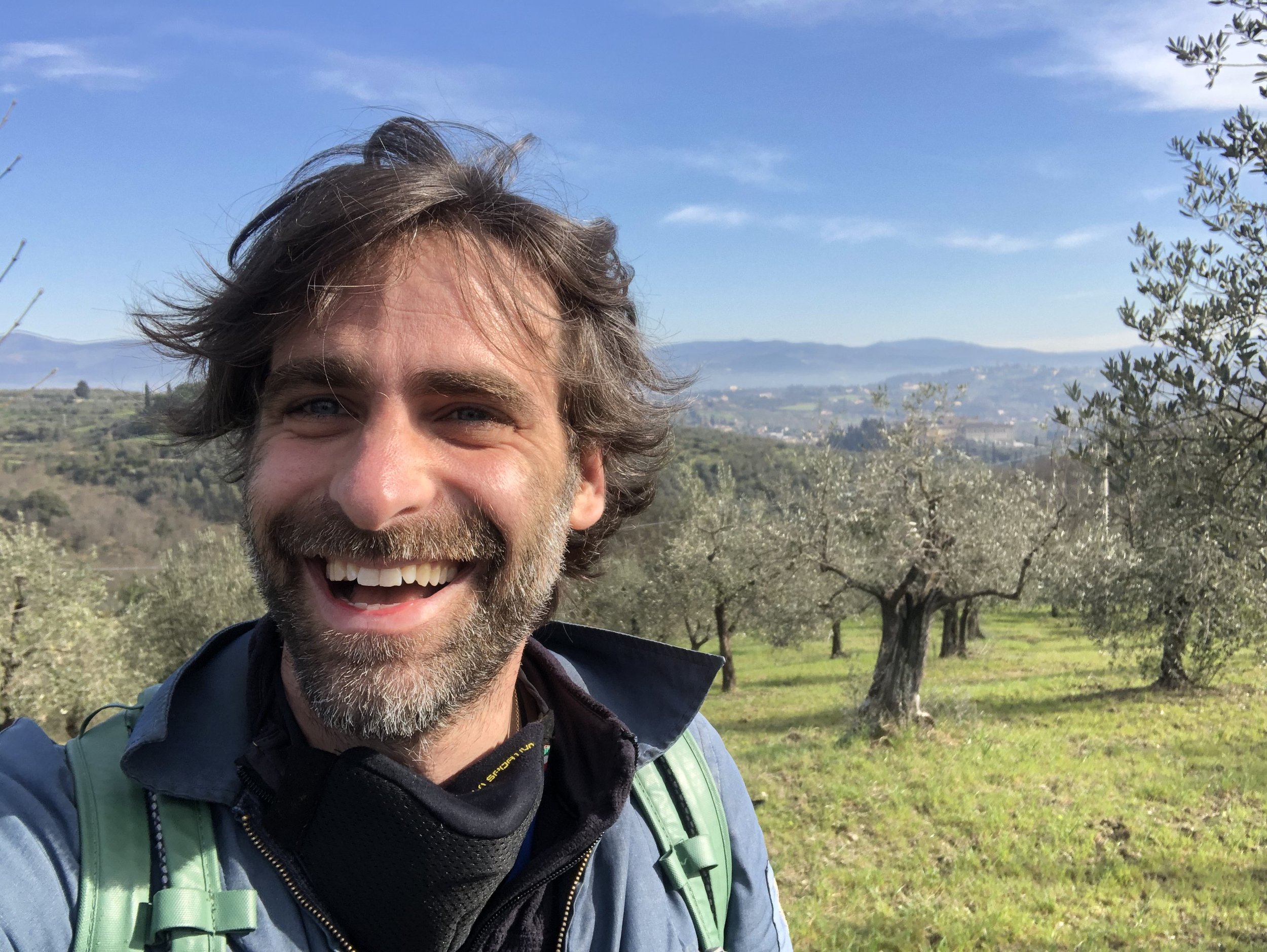

How the wine industry in Tuscany has changed over time
Interest in Tuscan wines is quite recent, with an early boom in the 1970s accompanying the development of the “Super Tuscans”, and a more recent explosion in popularity over the past two decade. Wine production is now one of the most thriving industries in the region.
As the global population of wine enthusiasts has fallen in love with Tuscan wine, exports and sales have increased exponentially. Prices too have risen accordingly. Don’t come to Tuscany expecting cheap prices - they are humble wines no more.
Interestingly, while interest in Tuscan wine is ever-increasing, next door in France, the Bordeaux region (a major producer of red wines) has actually seen a dip in consumption, resulting in an overproduction of red wine and surpluses.
In some cases, producers have gone as far as to remove vineyards to make way for the cultivation of other crops. In Tuscany, we have not seen any such slowdown. Tuscan brands continue to perform very well in the market and are synonymous with quality.
This unparalleled success internationally has led to lots of interest from big producers and investment funds though, and this is starting to distort the industry in odd ways. Unfortunately, quality is dipping.
Just consider the fact that you can find a Brunello di Montalcino DOCG, a very distinguished wine with the most stringent certification, for only 13€ in a supermarket. This is a ridiculously low price point and should absolutely not be possible.
So why is it? Well, big players have entered the scene and begun buying certified grapes from the Montalcino region and assembling them in their “cellars”, which are really just enormous factories. Mass-purchased grapes have low quality control and issues are common. To cover up these defects, producers add all sorts of chemicals to the wine.
This then allows them to sell millions of bottles of subpar wine at ridiculously low prices. Antinori, Frescobaldi, Piccini, and Geografico, are often cited as some of the worst offenders and many blame them for seriously harming the Brunello di Montalcino brand.
So, even if for now the quality of Tuscan wines is still recognized worldwide, the type of production that we’re currently seeing will likely put many authentic, local producers out of business, leaving us mostly with poor quality, big brand wines.
On a more positive note, many small producers are becoming organic/biodynamic in the hopes of further increasing the quality and sustainability of their products, helping them to stand out in a crowded field.
While there is scant scientific evidence to show the benefits of organic wine production on taste, a vineyard that chooses this process is certainly giving more attention to the natural aspects of their winemaking and they generally maintain extremely tight quality control and high standards throughout their production. Visiting these producers is always very pleasant.
Wine in ancient Tuscany
Wines and Tuscany - who knows when this beautiful relationship started...
Going back 3,000 years to pre-Roman times and the Etruscans, there is historical evidence showing that this ancient civilization had notable grape cultivation and wine production. While this is the first period for which we have hard evidence of wine in Tuscany, it’s fairly likely that the Etruscans weren’t the first to discover it.
Regardless of when wine first arrived here, the Etruscans were the first civilization to leave traces of its impact and role in their society. Thanks to their prosperous trading system with Greece and Mesopotamia, they were able to produce and trade wines in abundance, and there’s even some evidence to show that they produced imitation Greek wines (which were favored at the time) and sold them as authentic to to tribes living along the French coastline. Let’s call them early Italian entrepreneurs!
If you’re wondering what these ancient wines were like, know that they had few similarities with what we drink today. Etruscan vino was sweet, often mixed with spices, honey, and fruit, and it were served hot and diluted with water. Low in alcohol, these watered-down wines were intended to be drunk in big quantities.
Somewhat counterintuitively, only peasants drank straight, high-alcohol wines. This practice of watering down wine remained until modern times, only really fading away after World War 2.
Of course, this is quite different from today, when many wines are 14 or 15% alcohol, and full bodied, fully ripened, and very aromatic. The Etruscans would not have approved! But as you can see, times and tastes change.
Until modern times, wine production in Tuscany was also much less of a science. It was common for wines to have noticeable defects for a variety of reasons, which is in part what led to the tradition of serving wine with cheese.
Not many people know this, but cheese (milk fats in general) covers many defects, including issues with acidity and tannins, which are predominant aspects of Tuscan wines. So next time you’re served cheese with your wine, give that wine a second taste!



Connect with Stefano!
